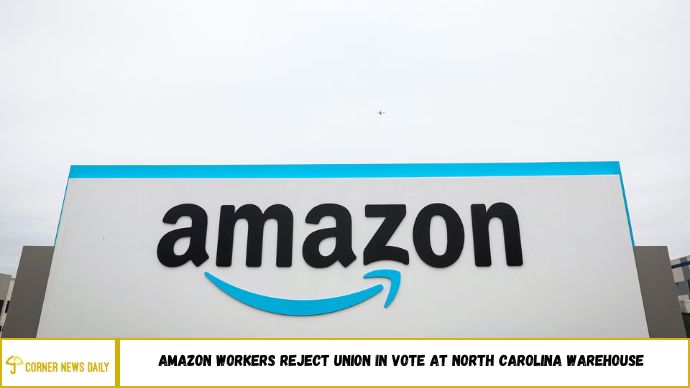Amazon Workers Reject Union in Vote at North Carolina Warehouse In recent years, labor movements have gained significant momentum, particularly within large corporations. One of the companies at the forefront of these debates is Amazon, a retail giant known for its massive workforce and, more recently, its ongoing battle against unionization efforts. On Saturday, workers at Amazon’s RDU1 facility in Garner, North Carolina, delivered a decisive vote, rejecting the proposal to unionize. This outcome is a significant moment in the ongoing conversation about labor rights within major tech and retail companies. The vote came after a heated three-year campaign led by the Carolina Amazonians United for Solidarity and Empowerment (CAUSE), which pushed for better wages, improved benefits, and enhanced working conditions for Amazon’s employees.
While Amazon has long been known for opposing unionization, this vote marks another chapter in a larger national discussion about workers’ rights and corporate influence. The rejection of the union in North Carolina, however, may not be the end of the story. In light of similar efforts succeeding elsewhere, including at other Amazon locations, the company’s resistance to unions will likely continue to be challenged by workers pushing for change. But what does this outcome really mean for both Amazon and the broader labor movement? In this article, we will take a closer look at the vote, the factors that influenced the outcome, and the future of unionization efforts at Amazon.
Amazon Workers Overwhelmingly Reject Unionizing Efforts
On Saturday, workers at Amazon’s RDU1 warehouse, located in Garner, North Carolina, voted by a significant margin against forming a union. Out of the 3,276 ballots cast, 2,447 votes were against unionization, while 829 voted in favor, according to the National Labor Relations Board (NLRB). Although 77 ballots were challenged, the narrow margin is unlikely to affect the outcome.
This defeat represents the culmination of a three-year campaign led by the Carolina Amazonians United for Solidarity and Empowerment (CAUSE), an employee-driven organization. CAUSE had advocated for better wages, longer breaks, and improved working conditions. Despite their efforts, Amazon’s resistance to unionization prevailed once again.
What Led to the Rejection of the Union?
The election results came after a highly contentious campaign. Amazon actively campaigned against unionization efforts, using its own platforms, including its AtoZ app and internal communications, to push back against the union. Warehouse leaders and Amazon representatives emphasized that the company’s current practices allowed for direct communication with management, avoiding the need for an intermediary.
In response to the outcome, CAUSE expressed frustration, claiming that Amazon’s “illegal” tactics, including intimidation and misinformation, contributed to the results. They argued that Amazon was determined to break the law to prevent workers from organizing. However, Amazon has denied these accusations, stating that they merely facilitated an open discussion for workers to make an informed decision.
Amazon’s History of Opposition to Unions
Amazon’s stance on unions is not new. The company has long opposed unionization efforts at its facilities, citing a preference for direct employee-management communication. While the company has successfully blocked union efforts in the past, it has faced growing challenges in recent years, particularly after workers at a Staten Island facility voted to form the Amazon Labor Union in 2022.
Despite Amazon’s previous successes in defeating unionization attempts, the recent surge in labor movements across industries signals a shifting tide. The outcome at the North Carolina facility is part of a broader national conversation on labor rights and corporate responsibility, as more workers across various sectors begin to seek collective bargaining power.
The Future of Amazon and Labor Organizing
Though Amazon workers in North Carolina rejected unionization, the overall trend of increasing labor activism in tech companies is undeniable. The success of unionization efforts at other Amazon facilities, such as the Staten Island warehouse and even at a Whole Foods location in Philadelphia, suggests that the fight for labor rights within the company is far from over.
With union campaigns gaining momentum, it will be interesting to see if Amazon adjusts its tactics or policies in response to these growing demands. The company’s ongoing battle against unionization, particularly in areas like pay raises, benefits, and workplace conditions, is expected to continue to make headlines in the coming years.
May you also like it:
What’s the Future of UNC Basketball’s Dean E. Smith Center? Something Needs to Be Done
Five Key Takeaways from the TaylorMade Driving Relief Match
Billionaire Elon Musk’s xAI to Launch Grok 3 Chatbot on Monday
Conclusion
The rejection of unionization at Amazon’s North Carolina warehouse marks a significant moment in the labor movement within the tech and retail industries. While Amazon’s efforts to maintain its non-unionized workforce have been successful at this location, broader trends indicate that labor movements across industries are gaining strength. Amazon, and other companies in similar positions, will need to pay close attention to the evolving landscape of employee rights and unionization efforts.
FAQ
What happened in the Amazon union vote in North Carolina?
Workers at Amazon’s RDU1 warehouse voted against unionizing, with 2,447 votes against and 829 in favor.
How many employees voted in the Amazon union election?
A total of 3,276 ballots were cast during the vote.
Who led the unionization effort at Amazon’s North Carolina warehouse?
The unionization effort was led by Carolina Amazonians United for Solidarity and Empowerment (CAUSE).
Did Amazon interfere with the union vote?
CAUSE accused Amazon of breaking the law and using intimidation tactics, but Amazon denied any wrongdoing.
Why did Amazon workers reject the union?
Amazon’s anti-union campaign and arguments for direct employee-management communication were significant factors in the rejection.
What is the future of labor organizing at Amazon?
While the vote was a setback, labor activism is gaining momentum at Amazon, and union efforts are expected to continue across other locations.

